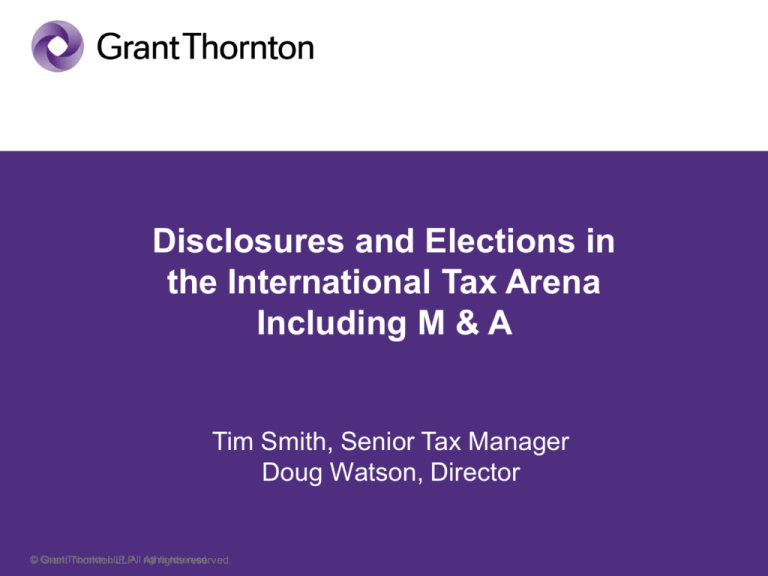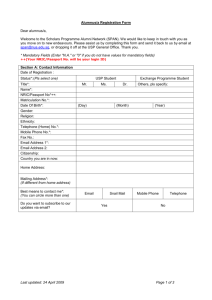
Disclosures and Elections in
the International Tax Arena
Including M & A
Tim Smith, Senior Tax Manager
Doug Watson, Director
© Grant
LLP.
All rights
reserved.
GrantThornton
Thornton
LLP.
All rights
reserved.
Disclosure and Elections for International
Transactions
•
•
•
•
•
•
Check the Box Elections
Corporate Organizations
Taxable Corporate Acquisitions
Corporate Liquidations
Corporate Stock Redemptions
Tax-free Reorganizations
2
© Grant Thornton LLP. All rights reserved.
Check-the-Box-Elections
Formation/Organization of Foreign Entity that Elects to be Treated as a
Flow-Through Entity
USP
CFC
CFC (or US Parent)
Forms/Organizes a
Foreign Entity that
Elects to be Treated
as a Disregard Entity
Foreign
Eligible
Entity
3
© Grant Thornton LLP. All rights reserved.
Check-the-Box-Elections
Formation/Organization of Foreign Entity that Elects to be Treated as a
Flow-Through Entity
Disclosures and Elections
• Form 8832
• Form SS–4
• Form 8858
4
© Grant Thornton LLP. All rights reserved.
Check-the-Box-Elections
Conversion of Less Than 100% Owned Foreign Corporation to a Foreign
Partnership
Foreign Corporation
Elects to be Treated as
a Foreign Partnership.
The transaction is
treated as a
distribution by FC of
all its assets and
liabilities to USP in
liquidation followed by
a contribution of those
assets and liabilities
to Foreign PRS under
Treas. Reg. § 301.7701
– 3(g)(1)(ii)
USP
USP
FC
Foreign
PRS
5
© Grant Thornton LLP. All rights reserved.
Check-the-Box-Elections
Conversion of Less Than 100% Owned Foreign Corporation to a Foreign
Partnership
Disclosures and Elections
•
Form 8832
•
Form 5471, Schedule O if FC is a CFC
•
Form 8865, including Schedule O
•
Section 367(b) Notice
– Attach to USP's return
•
Section 331 Statement
– Attach to USP's return
– Treas. Reg. § 1.331-1(d)
– Applies if USP owns less than 80% of
CFC
– This notice is only required if USP owns
80% or more of CFC and thus the
liquidation qualifies under Section 332
•
Section 332 Statement
– Attach to USP's return
– Treas. Reg. § 1.332 - 6(a)
– Applies if USP owns 80% or more of FC
•
Form SS-4
6
© Grant Thornton LLP. All rights reserved.
Check-the-Box-Elections
Deemed Liquidation of CFC by Electing to be Treated as a Disregarded
Entity
CFC Elects to be
Treated as a
Disregarded Entity.
The transaction is
treated as a deemed
liquidation of the CFC
under Treas. Reg. §
301.7701 – 3(g)(1)(iii).
USP
CFC
7
© Grant Thornton LLP. All rights reserved.
Check-the-Box-Elections
Deemed Liquidation of CFC by Electing to be Treated as a Disregarded
Entity
Disclosures and Elections
•
Form 8832
•
Section 332 Statement
– Attach to USP's return
– Treas. Reg. § 1.332 - 6(a)
– Applies if USP owns 80% or more of
CFC
•
•
Section 331 Statement
– Attach to USP's return
– Treas. Reg. § 1.331-1(d)
– Applies if USP owns less than 80% of
CFC
Section 367(b) Notice
– Attach to USP's return
– This notice is only required if USP owns
80% or more of CFC and thus the
liquidation qualifies under Section 332
•
Form 5471, Schedule O
•
Form 8858
•
Form SS-4
8
© Grant Thornton LLP. All rights reserved.
Check-the-Box-Elections
Foreign Disregarded Entity Elects to be Treated as a Corporation
Foreign Disregarded
Entity Elects to be
Treated as a
Corporation.
The transaction is
treated as a
contribution by USP
of all the assets and
liabilities of Foreign
DRE to CFC in
exchange for stock
of CFC under Treas.
Reg. § 302.7701 –
3(g)(1)(iv)
USP
USP
Foreign
DRE
CFC
9
© Grant Thornton LLP. All rights reserved.
Check-the-Box-Elections
Foreign Disregarded Entity Elects to be Treated as a Corporation
Disclosures and Elections
•
Form 8832
•
Form SS-4
•
Form 926 and Section 6038B Statement
•
Section 964, First Year Accounting Methods
Election
–
Election may be made upon
organization of CFC; attach to CFC's
Form 5471
– Attach to USP's return
–
– Treas. Reg. § 1.6038B – 1(b)(l)(i) and
§ 1.6038 – 1T(c)
Election required when E & P of CFC is
"significant" for federal tax purposes
–
Treas. Reg. § 1.964 – 1(c)(3)(ii) and
§ 1.964 – 1(c)(6)
•
Form 5471, Schedule O
•
Section 351 Statement
– Attach to USP's return
– Statement under Treas. Reg. § 1.351
- 3(b) not required
10
© Grant Thornton LLP. All rights reserved.
Check-the-Box-Elections
Foreign Partnership Elects to be Treated as a Foreign Corporation
Foreign Partnership
Elects to be Treated as a
Foreign Corporation.
The transaction is treated
as a contribution by the
foreign partnership of all
its assets and liabilities to
FC followed by the
liquidation of the foreign
partnership (i.e., USP)
and then a distribution of
FC's stock to its partners
under Treas. Reg. §
301.7701 – 3(g)(1)(i)
USP
Foreign
PRS
USP
FC
11
© Grant Thornton LLP. All rights reserved.
Check-the-Box-Elections
Foreign Partnership Elects to be Treated as a Foreign Corporation
Disclosures and Elections
•
Form 8832
•
Form 5471, Schedule O
•
Form 8865, Schedule P
•
Form 926 and Section 6038B Statement
•
– Election may be made upon
organization of CFC
– Attach to USP's return
– Election required when E & P of
CFC is "significant" for federal tax
purposes
– Treas. Reg. § 1.6038B – 1(b)(1)(i)
and § 1.6038 – 1T(c)
•
– Treas. Reg. § 1.964 – 1(c)(3)(ii) and
§ 1.964 – 1(c)(6)
Section 351 Statement
– Attach to USP's return
– Statement under Treas. Reg. § 1.351
- 3(b) not required
Section 964, First Year Accounting
Methods Election – attach to CFC's
Form 5471
•
Form SS-4
12
© Grant Thornton LLP. All rights reserved.
Corporate Organizations
US Parent Forms CFC and Contributes Property to CFC
USP
US parent contributes
property to CFC for use in
an active trade or business
outside the US
CFC
13
© Grant Thornton LLP. All rights reserved.
Corporate Organizations
US Parent Forms CFC and Contributes Property to CFC
Disclosures and Elections
•
Form 926 filed by USP
•
Statement under Treas. Reg. § 1.6038B – 1(b)(l)(i) and Temp. Treas. Reg. § 1.6038B-1T(c)
filed by USP
•
Form 5471, Schedule O (Required only if contribution is part of the organization of the CFC)
•
Section 351 Statement
– Filed by USP on behalf of CFC
– Treas. Reg. § 1.351-3(a)
– Treas. Reg. § 1.351-3(b) requires CFC to file a § 351 statement, but this is not required
if USP makes complete disclosure under Treas. Reg. § 1.351-3(a)
•
Section 964, first year accounting methods selection
– Election may be made upon organization of CFC; attach to CFC's Form 5471
– Election required when E & P of CFC is "significant" for federal tax purposes
– Treas. Reg. § 1.964 – 1(c)(3)(ii) and § 1.964 – 1(c)(6)
14
© Grant Thornton LLP. All rights reserved.
Corporate Organizations
CFC1 Forms CFC2 and Contributes Property to CFC2
USP
CFC1 contributes
property to CFC2 for
use in an active trade
or business outside
the US
CFC1
CFC2
15
Corporate Organizations
CFC1 Forms CFC2 and Contributes Property to CFC2
Disclosures & Elections
•
Form 5471, Schedule O (Required only if contribution is part of the organization of the CFC2)
•
Section 351 Statement
– Filed by USP on behalf of CFC
– Treas. Reg. § 1.351-3(a)
– Treas. Reg. § 1.351-3(b) requires CFC to file a § 351 statement, but this is not required if
USP makes complete disclosure under Treas. Reg. § 1.351-3(a)
•
Section 367(b) Notice
– Filed by USP and CFC1
– Treas. Reg. § 1.367(b) – 1(c)
•
Section 964, first year accounting methods selection ; attach to CFC2's Form 5471
– Election may be made upon organization of CFC
– Election required when E & P of CFC is "significant" for federal tax purposes
– Treas. Reg. § 1.964 – 1(c)(3)(ii) and § 1.964 – 1(c)(6)
16
Corporate Organizations
US Parent Contributes Stock of CFC1 to CFC2
USP
CFC1
USP owns 100% of
CFC1 and CFC2 and
transfers 80% or
more of the stock of
CFC1 to CFC2
CFC2
CFC1
17
© Grant Thornton LLP. All rights reserved.
Corporate Organizations
US Parent Contributes Stock of CFC1 to CFC2
Disclosures and Elections
•
Form 5471, Schedule O
•
Form 8838, Consents to Extend the Time to Assess Tax under Section 367 – Gain Recognition Agreement – filed by USP
•
Gain Recognition Agreement (GRA) – Treas. Reg. § 1.367(a) – 8(c)(2) & (3) – filed by USP
–
New Regulation, Nov, 19, 2014: Use of "available upon request" or similar descriptions instead of provided
information for a GRA constitutes a willful failure to comply with the regulations
•
Annual Gain Recognition Agreement Certification – Treas. Reg. § 1.367(a) – 8(g) – filed by USP
•
Section 367(b) Notice - Treas. Reg. § 1.367(b) – 1(c) – filed by USP
•
Section 351 Statement
•
–
Filed by USP
–
Treas. Reg. § 1.351-3(a)
–
Treas. Reg. § 1.351-3(b) requires CFC to file a § 351 statement, but this is not required if USP makes complete
disclosure under Treas. Reg. § 1.351-3(a)
Section 926 and Statement under Treas. Reg. § 1.6038 B – 1(b)(l)(i) and (2)
–
New Regulation, Nov. 19, 2014: If GRA is filed, Form 926 and the § 6038B statement are required
18
© Grant Thornton LLP. All rights reserved.
Corporate Organizations
Partnership (US or Foreign) Forms CFC or Contributes Property to CFC
USP
Domestic or foreign
partnership
contributes
property to CFC for
use in an active
trade or business
outside the US
PRS
CFC
19
© Grant Thornton LLP. All rights reserved.
Corporate Organizations
Partnership (US or Foreign) Forms CFC or Contributes Property to CFC
Disclosures and Elections
•
Form 926 filed by USP
•
Statement under Treas. Reg. § 1.6038 B – 1(b)(l)(i) and Temp. Treas. Reg. § 1.6038B – 1T(c)
•
Form 5471, Schedule O (Required only if contribution is part of the organization of the CFC)
•
•
–
If PRS is domestic, attach Form 5471 to Form 1065
–
If PRS is foreign, USP files Form 5471
Section 351 Statement
–
Attach to Form 1065 or 8865
–
Treas. Reg. § 1.351-3(a)
–
Treas. Reg. § 1.351-3(b) requires CFC to file a § 351 statement, but this is not required if PRS makes complete
disclosure under Treas. Reg. § 1.351-3(a)
Section 964, first year accounting methods selection; attach to CFC's Form 5471
–
Election may be made upon organization of CFC
–
Election required when E & P of CFC is "significant" for federal tax purposes
–
Treas. Reg. § 1.964 – 1(c)(3)(ii) and § 1.964 – 1(c)(6)
20
© Grant Thornton LLP. All rights reserved.
Taxable Corporate Acquisitions
CFC Acquires Assets of Target for Property
CFC
acquires
assets of
target for
property
(e.g. cash
or debt)
USP
CFC
Assets
Target
Property
21
© Grant Thornton LLP. All rights reserved.
Taxable Corporate Acquisitions
CFC Acquires Assets of Target for Property
Disclosures and Elections
•
Form 8594 – Asset Acquisition Statement
– Attach to CFC's Form 5471
– Only required if trade or business assets are bought or sold
– Treas. Reg. § 1.1060 – 1(e)
22
© Grant Thornton LLP. All rights reserved.
Taxable Corporate Acquisitions
US Parent Acquires Foreign Target for Property and Makes a Section 338(g)
Election
US Parent
acquires
the stock of
target for
property
and makes
a Section
338(g)
election
Property
USP
Seller
Target Stock
Foreign
Target (CFC)
Foreign
Target
23
© Grant Thornton LLP. All rights reserved.
Taxable Corporate Acquisitions
US Parent Acquires Foreign Target for Property and Makes a Section 338(g)
Election
Disclosures and Elections
•
•
•
Form 5471, Schedule O for Foreign Target
– Applies to USP's Form 5471
– Applies to Sellers Form 5471 if Seller is a US
Person
Form 8023, Election under Section 338 for
Corporations Making Qualified Stock Purchases
– Filed by USP
– Due the 15th day of the 9th month beginning
after the month the acquisition occurs
– Treas. Reg. § 1.338 - 2(c)(14) and 2(d)
Form 8883, Asset Allocation Statement under
Section 338
– Filed by USP
– Attach to Foreign Target's Form 5471
– If Seller is US person, it must also file a Form
8883
•
Section 338 Election Notice
–
This Notice is only required if Foreign
Target was a CFC, PFIC or FPHC during
its tax year that ends on the acquisition
date
–
Election is due the later of 120 days after
the acquisition or the date Form 8023 is
filed
USP (purchaser) must deliver written
notice of the election and a copy of the
Form 8023 to:
–
–
1.
Each US person that held stock in the
Foreign Target on the acquisition date
2.
Each US person that sold stock in the
Foreign Target during the 12 month
acquisition period if the Foreign
Target was a CFC, PFIC or FPHC
Treas. Reg. § 1.338 - 2(e)(4)
24
© Grant Thornton LLP. All rights reserved.
Taxable Corporate Acquisitions
US Parent Acquires Foreign Target for Property and Makes a Section
338(g) Election (Continued)
•
Section 1248 Schedule
– Applies only if Seller is a US
corporation
– Attached to Seller's return
– Treas. Reg. § 1.381(b) – 1
•
Section 964, first year accounting methods
selection
– Election may be made upon
organization of CFC – Attach to CFC's
Form 5471
•
Election to step-up basis in nonrecently purchased stock
– Only applies if purchasers
(USP) held shares in Foreign
Target prior to the Section 338
transaction
– Attach to Form 8023
– Treas. Reg. § 1.388 – 5(d)
– Election required when E & P of CFC is
"significant" for federal tax purposes
– Treas. Reg. § 1.964 – 1(c)(3)(ii) and §
1.964 – 1(c)(6)
25
© Grant Thornton LLP. All rights reserved.
Taxable Corporate Acquisitions
US Parent Sells CFC to Unrelated (US or Foreign) Acquiror for Property
Property
USP
Acquiror
Foreign
Target Stock
Foreign
Target (CFC)
Foreign
Target
US Parent Sells CFC to Unrelated (US
or Foreign) Acquiror for Property
26
© Grant Thornton LLP. All rights reserved.
Taxable Corporate Acquisitions
US Parent Sells CFC to Unrelated (US or Foreign) Acquiror for Property
Disclosures and Elections
•
Form 5471, Schedule O
•
Section 1248 Schedule
– USP attaches to its return
– Treas. Reg. § 1.1248(b) – 7
27
© Grant Thornton LLP. All rights reserved.
Corporate Liquidations
CFC Liquidates into US Parent
USP
CFC (at least 80%
owned) liquidates
into US Parent
CFC
28
© Grant Thornton LLP. All rights reserved.
Corporate Liquidations
CFC Liquidates into US Parent
Disclosures and Elections
•
Section 332 Statement
– Filed with USP's return
– Treas. Reg. § 1.332 - 6(a)
•
Form 966 – Corporate Dissolution or Liquidation
– Due within 30 days after the plan to dissolve
or liquidate the corporation
– Form 966 is only required if CFC is required
to file a US tax return (e.g. Form 1120-F)
•
Form 5471, Schedule O
•
Election to carryover corporate
attributes in a reorganization or 332
liquidation
– Attach to USP's return as US
shareholder
– Attach to Form 5471 for CFC
– Treas. Reg. § 1.381(b) - 1
– Treas. Reg. § 1.6043 – 1(a) and (b)
•
Section 367(b) Notice
– Attach to USP's return and CFC's Form 5471
29
© Grant Thornton LLP. All rights reserved.
Corporate Liquidations
CFC2 Liquidates into CFC1
USP
CFC1
USP owns 100% of
CFC1, which owns at
least 80% of CFC2 and
CFC2 liquidates into
CFC1
CFC2
30
© Grant Thornton LLP. All rights reserved.
Corporate Liquidations
CFC2 Liquidates into CFC1
Disclosures and Elections
•
Section 332 Statement
– Filed with USP's return
– Treas. Reg. § 1.332 - 6(a)
•
Form 966 – Corporate Dissolution or Liquidation
•
•
Form 5471, Schedule O for both CFC1
and CFC2
Election to carryover corporate attributes
in a reorganization or 332 liquidation
– Due within 30 days after the plan to
dissolve or liquidate the corporation
– Attach to USP's return as US
shareholder
– Form 966 is only required if CFC2 is
required to file a US tax return (e.g. Form
1120-F)
– Attach to each Form 5471 for CFC1
and CFC2
– Treas. Reg. § 1.381(b) - 1
– Treas. Reg. § 1.6043 – 1(a) and (b)
•
Section 367(b) Notice
– Attach to USP's return and CFC1's Form
5471
31
© Grant Thornton LLP. All rights reserved.
Corporate Stock Redemptions
CFC Redeems Stock Held by US Parent
CFC Redeems Stock
Held by US Parent
and redemption is
treated as a Section
301 distribution
USP
Stock of
CFC
Property
CFC
32
© Grant Thornton LLP. All rights reserved.
Corporate Stock Redemptions
CFC Redeems Stock Held by US Parent
Disclosures and Elections
• Section 302 Statement
– USP attaches to its return
– Treas. Reg. § 1.302 - 2(b)(2)
33
© Grant Thornton LLP. All rights reserved.
Corporate Stock Redemptions
CFC2 Acquires the Stock of CFC1 from US Parent
CFC2 acquires the
stock of CFC1 from
US Parent. USP is
treated as
contributing CFC1
stock to CFC2 for
CFC2 stock in a
Section 351
transaction. CFC2 is
treated as redeeming
the stock issued to
USP.
USP
CFC1
CFC2
CFC1
34
© Grant Thornton LLP. All rights reserved.
Corporate Stock Redemptions
CFC Redeems Stock Held by US Parent
Disclosures and Elections
•
Section 351 Statement
–
Attach to USP's return
–
Statement under Treas. Reg. § 1.351 - 3(b)
•
–
not required
•
Form 926 and Section 6038B Statement
•
Section 302 Statement
–
Attach to USP's return
–
Treas. Reg. § 1.302 – 2(b)(2)
Gain Recognition Agreement - Treas. Reg. §
1.368(a) – 8(c)(2) and (3) filed by USP
New Regulation, Nov. 19, 2014: use of
"available upon request" or similar
descriptions instead of actual information in
connection with a GRA constitutes a willful
failure to comply
•
Annual Gain Recognition Agreement Certification Treas. Reg. § 1.367(a) – 8(g) filed by USP
•
Section 367(b) Notice
– Attach to USP's return
– Treas. Reg. § 1.367(b) – 1(c)
35
© Grant Thornton LLP. All rights reserved.
Tax-Free Corporate Reorganizations
US Parent Contributes the Stock of CFC1 to CFC2 in Exchange for Solely
CFC2 Voting Stock – "B" Reorganization/Section 351
USP
US Parent
Contributes 80% or
more of the Stock of
CFC1 to CFC2 in
Exchange for Solely
CFC2 Voting Stock
CFC1
CFC2
CFC1
36
© Grant Thornton LLP. All rights reserved.
Tax-Free Corporate Reorganizations
US Parent Contributes the Stock of CFC1 to CFC2 in Exchange for Solely
CFC2 Voting Stock – "B" Reorganization/Section 351
Disclosures and Elections
•
Form 5471, Schedule O for CFC2
•
Form 8838 filed by USP
•
Gain Recognition Agreement - Treas. Reg. §
1.368(a) – 8(c)(2) and (3) filed by USP
–
•
•
•
•
– Attach to USP's return - Treas. Reg.
§ 1.351 - 3(a)
New Regulation, Nov. 19, 2014: use of
"available upon request" or similar descriptions
instead of actual information in connection with a
GRA constitutes a willful failure to comply
Annual Gain Recognition Agreement
Certification - Treas. Reg. § 1.367(a) – 8(g) filed
by USP
Section 367(b) Notice
– Attach to USP's return
– Treas. Reg. § 1.367(b) – 1(c)
Section 368 Statements
– Attach to USP's return
– Treas. Reg. § 1.3683(a) and (b)
Section 351 Statement
– Statement under Treas. Reg. §
1.351 - 3(b) not required
•
Form 926 and § 6038B Statement
– Statement under Treas. Reg. §
1.6038B – 1(b)(l)(i) and (2)
–
New Regulation, Nov. 19, 2014 Form
926 and § 6038B statement is required if
USP files a GRA
37
© Grant Thornton LLP. All rights reserved.
Tax-Free Corporate Reorganizations
US Parent Contributes the Stock of CFC1 to CFC2 and CFC1 Liquidates –
"D" Reorganization
USP
CFC1
US Parent Contributes the
Stock of CFC1 to CFC2
and CFC1 either
Liquidates or Elects to be
Treated as Disregarded
CFC2
CFC1
38
© Grant Thornton LLP. All rights reserved.
Tax-Free Corporate Reorganizations
US Parent Contributes the Stock of CFC1 to CFC2 and CFC1 Liquidates –
"D" Reorganization
Disclosures and Elections
•
Form 5471, Schedule O for CFC1 and CFC2
•
Section 367(b) Notice
–
–
•
•
•
Attach to USP's return and CFC2's Form
5471
Treas. Reg. § 1.367(b) – 1(c)
Section 368 Statements
–
Attach to USP's return
–
Treas. Reg. § 1.368 - 3(a) and (b)
Form 966 – Corporate Dissolution or Liquidation
–
Due within 30 days after the plan to dissolve
or liquidate the corporation
–
Form 966 is only required if CFC1 is required
to file a US tax return (e.g. Form 1120-F)
–
Treas. Reg. § 1.6043 – 1(a) and (b)
•
Form 8832
–
Filer is CFC1, not USP
–
Attach to CFC1's Form 8858
–
May need to apply for EIN by filing
Form SS-4
Election to carryover corporate attributes in
a reorganization or 332 liquidation
–
Attach to USP's return as US
shareholder
–
Attach to Form 5471 for CFC2
–
Treas. Reg. § 1.381(b) - 1
39
© Grant Thornton LLP. All rights reserved.
Tax-Free Corporate Reorganizations
US Parent Recapitalizes CFC – "E" Reorganization
USP
US Parent Converts
Debt/Receivable from
CFC to Equity in CFC
CFC
40
© Grant Thornton LLP. All rights reserved.
Tax-Free Corporate Reorganizations
US Parent Recapitalizes CFC – "E" Reorganization
Disclosures and Elections
•
Form 5471, Schedule O, but only if USP's interest in CFC increases by 10% or
more
•
Section 367(b) Notice
– Attach to USP's return and CFC's Form 5471
– Treas. Reg. § 1.367(b) – 1(c)
•
Section 368 Statements
– Attach to USP's return
– Treas. Reg. § 1.368 - 3(a) and (b)
41
© Grant Thornton LLP. All rights reserved.
Tax-Free Corporate Reorganizations
US Parent Contributes the Stock of CFC1 to New CFC2 and CFC1
Liquidates "F" Reorganization
USP
CFC1
US Parent Contributes
the Stock of CFC1 to New
CFC2 and CFC1 either
Liquidates or Elects to be
Treated as Disregarded
New
CFC2
CFC1
42
© Grant Thornton LLP. All rights reserved.
Tax-Free Corporate Reorganizations
US Parent Contributes the Stock of CFC1 to New CFC2 and CFC1
Liquidates "F" Reorganization
Disclosures and Elections
•
Form 5471, Schedule O
•
– CFC2 is treated as a continuation of CFC1
– Due within 30 days after the plan
to dissolve or liquidate the
corporation
– Form 5471 covers full year
– Name on Form 5471 is CFC2 (FKA CFC1)
– Treas. Reg. § 1.6038 – 2 and § 1.367(b) –
2(b)
•
– Form 966 is only required if CFC1
is required to file a US tax return
(e.g. Form 1120-F)
Section 367(b) Notice
– Treas. Reg. § 1.6043 – 1(a) and
(b)
– Attach to USP's return and CFC2's Form
5471
•
Section 368 Statements
– Attach to USP's return
– Treas. Reg. § 1.368 - 3(a) and (b)
Form 966 – Corporate Dissolution or
Liquidation
•
Form 8832
– Filer is CFC1, not USP or CFC2
– Attach to CFC1's Form 8858
– May need to apply for EIN by
filing Form SS-4
43
© Grant Thornton LLP. All rights reserved.
Tax-Free Corporate Reorganizations
US Parent Contributes the Stock of CFC1 and CFC3 to CFC2 and CFC1
Liquidates "D" Reorganization
USP
US Parent
contributes the
Stock of CFC1 to
new CFC2 and
CFC1 either
liquidates or
elects to be
treated as
disregarded
CFC1
CFC2
CFC3
CFC1
CFC3
44
© Grant Thornton LLP. All rights reserved.
Tax-Free Corporate Reorganizations
US Parent Contributes the Stock of CFC1 and CFC3 to CFC2 and CFC1
Liquidates "D" Reorganization
Disclosures and Elections
•
Form 5471, Schedule O for CFC 1 and CFC 2
•
Section 367(b) Notice
•
– Filer is CFC1, not USP or CFC2
– Attach to USP's return and CFC1's Form
5471
•
– Treas. Reg. § 1.368 - 3(a) and (b)
•
– Attach to CFC1's Form 8858
– May need to apply for EIN by filing
Form SS-4
Section 368 Statements
– Attach to USP's return
Form 966 – Corporate Dissolution or Liquidation
– Due within 30 days after the plan to dissolve
or liquidate the corporation
– Form 966 is only required if CFC1 is
required to file a US tax return (e.g. Form
1120-F)
Form 8832
•
Election to carryover corporate
attributes in a reorganization or 332
liquidation
– Attach to USP's return as US
shareholder
– Attach to Form 5471 for CFC2
– Treas. Reg. § 1.381(b) - 1
– Treas. Reg. § 1.6043 – 1(a) and (b)
45
© Grant Thornton LLP. All rights reserved.
Questions?
46
© Grant Thornton LLP. All rights reserved.
Are You Prepared To Successfully
Defend Your Transfer Pricing
Upon Audit?
Nick Scott, Transfer Pricing Director
© Grant
LLP.
All rights
reserved.
GrantThornton
Thornton
LLP.
All rights
reserved.
Agenda
•
Why TP Defense is Timely?
•
•
•
•
Best Practices
•
•
•
•
Overview
OECD Developments
State Transfer Pricing Landscape
Preparation
Manage and Defend
Learn and Improve
Next Steps
© Grant Thornton LLP. All rights reserved.
Why TP Defense is Timely
Overview
Your approach and level of investment will depend on the number of transactions,
materiality, and complexity/type of your intercompany transactions combined with
your appetite for risk -- One Size Does Not Fit All
•
Whatever the size of your company, consider the various
best practices and tailor them to best fit your situation
•
Regardless of the approach, be proactive and consider the
best practices at each stage of the transfer pricing life cycle:
•
•
•
•
Development and implementation of your transfer pricing
(including policies)
Audit preparation
Manage and defend your transfer pricing upon audit
Once audit is resolved, learn and improve from experience
© Grant Thornton LLP. All rights reserved.
Why TP Defense is Timely
Overview
•
•
•
•
•
For most corporations the largest tax exposure and risk is usually its transfer pricing
It's not a question of if, but when taxpayers will be audited
Factors increasing the chance of audit:
• Domestic
• States are hungry for revenue
• States are adding transfer pricing expertise
• International
• Issuance of OECD Transfer Pricing roadmap and BEPS initiatives
• Government need for more tax revenue
• Recent trend within MNCs, issuing tax transparency reports
Constantly changing TP environment
• States and countries recognize TP differently
• No domestic "competent authority" process
Taxpayers need to consider foreign and federal TP adjustments in state/international
tax audits
© Grant Thornton LLP. All rights reserved.
Why TP Defense is Timely
Will the OECD/UN increase transfer pricing controversy?
Tax authorities, OECD and UN, are issuing an increasing amount
of guidance in areas that could affect transfer pricing:
• Discussion Draft on Intangibles
• Broad definition of intangibles
• White paper on country by country reporting
• OECD Transfer Pricing Risk Assessment Handbook
• OECD Action Items:
• 8,9,10: Assure transfer pricing outcomes are in line
with value creation
• 11: Establish methodologies to collect and analyze
data on BEPS
• 13: Re-examine transfer pricing documentation
State tax authorities have the same concern!
© Grant Thornton LLP. All rights reserved.
Why TP Defense is Timely
State Transfer Pricing Landscape
•
•
•
•
•
•
•
Some states clearly adopt 482 and its regulations
• Approximately 15 states have separate 482 authority.
• Some states incorporate 482 as the standard for 482 mandatory combined
filing, others have the authority to separately compute federal taxable
income.
Historically, the separate entity states were not focused on transfer pricing.
These states had little or no expertise with transfer pricing.
Larger states (New York, California) have focused efforts on transfer pricing.
Today, both combined reporting and separate entity states are increasing their
focus and expertise on transfer pricing. In some cases states are hiring transfer
pricing experts to assist in their audits.
The Multistate Tax Commission (MTC) is seeking a contract with transfer pricing
firms to assist the MTC with state income tax audits.
In the current audit environment, the best practice is to have transfer prices
documented through regular transfer pricing studies every year.
During the course of a state transfer pricing audit, a transfer pricing expert can
help in resolving the state tax audit before appeals.
© Grant Thornton LLP. All rights reserved.
Why TP Defense is Timely
The "All-in" Cost of a Transfer Pricing Audit
• In addition to taxpayers paying more in taxes, audits:
• Increase tax reserves (multiple tax years involved)
• Lead to costly administrative appeals or court action
• Cause significant internal time and expense
• Result in material transfer pricing adjustments
• Earnings surprise
• Impact tax and transfer pricing business strategies and structures
• Result in unforeseen sales tax liabilities from state TP adjustments
Successful defense of your transfer pricing is not an accident, it is in your control.
Prepare in advance to successfully defend your transfer pricing upon audit!
© Grant Thornton LLP. All rights reserved.
Best Practices: Preparation for, Managing and
Defending, and Learning/Improving from a TP Audit
Manage &
Defend
Prepare
© Grant Thornton LLP. All rights reserved.
Learn &
Improve
•
•
•
Success!
No surprises
No TP adjustment
Release reserves
Best Practices: Preparing for, Managing and Defending,
and Learning/Improving from a TP Audit
Checklist
Preparing for an Audit
1. Possess the right mindset
2. Draw on past experiences
3. Have a strategy to manage the audit
4. Identify all intercompany transactions
5. Consider the effect of intercompany transactions and business strategies
6. Acknowledging the role of Special Purpose Entities
7. Importance of intercompany agreements
8. Explaining changes to transfer pricing policies
9. Intercompany Invoices
10. Operationalize transfer pricing
11. Prepare Contemporaneous Documentation
12. Consider M&A Activity
13. Evaluate Legal Entity Optimization
Managing and Defending the Audit
1. Responding to the audit
2. Appointing a single point of contact for responding to the audit
3. Balancing in-house expertise with outside transfer pricing specialists
Learning from the audit
1. Post-audit Debrief
© Grant Thornton LLP. All rights reserved.
Best Practices: Preparing for a TP Audit
Having a Strategy to manage the audit
Best Practice 3: In advance, develop a strategy and process to respond to an
information request; seek to manage the transfer pricing audit versus letting the audit
manage you
Items to consider in a successful end-to-end transfer pricing audit process
•
Have you identified all of your intercompany transactions?
•
Are you using best practices for intercompany agreements?
•
Does your G/L in your ERP system align with your intercompany
agreements? Can you generate the reports you need for the audit?
•
Do you have contemporaneous documentation if state so requires? Are they
well thought out, updated, and consistent/adaptable across the enterprise?
•
Will it impact your tax and transfer pricing business strategies and structures?
•
What will your strategy be to manage the audit?
© Grant Thornton LLP. All rights reserved.
Best Practices: Preparing for a TP Audit
Intercompany Agreements Matter--Tax Authorities Read What You Write!
Best Practice 7: Characteristics of a best-in-class intercompany agreement from a tax and transfer
pricing perspective:
•
Easy to read for all stakeholders involved
•
Risks should be allocated and reflect the operations
•
Market, Inventory, A/R, Forex, R&D, warranty, etc.
•
Tax clause detailing treatment of sales and use tax
•
Obtain input from SMEs (legal, IP counsel, treasury, etc.)
•
Ability to balance competing objectives to achieve an agreement beneficial to your
organization
Things to consider:
•
Do you bundle versus unbundle the various transactions?
•
Does the agreement reflect the actual transaction?
•
Do you periodically update the agreement for changes in your business?
•
Who reviews your agreement and approves changes?
•
Have your legal entities signed the agreement?
•
Do you store the signed agreement on a share point site so it is readily available on audit?
Getting the best intercompany agreement is a team effort!
© Grant Thornton LLP. All rights reserved.
Best Practices: Preparing for a TP Audit
Contemporaneous Documentation
Best Practice 11: Prepare Contemporaneous Documentation
•
Tells a good story, easy to follow
•
Seamlessly ties together the business, industry and transfer pricing approach
•
Reflective of intercompany agreements and invoices
•
Are agreements being lived and invoices followed
•
Consistent approach across major transactional groupings: states, countries, regions, and
business units/segments
•
Collect facts, benchmark, and monitor results real time and before the books close
•
Documentation constructed in an efficient, organized fashion
•
Use industry and business related factors to support your TP results
•
Functional analysis should clearly delineate
•
Who performs the routine (tactical) versus non-routine (strategic) functions
•
Who carries the relevant risks
•
Ownership of assets (such as IP)
•
Differentiate between high value services and routine services
•
It is extremely important that all methods have been evaluated and documented why or why
not they have been selected.
© Grant Thornton LLP. All rights reserved.
Next Steps: Consider the Following
• Strategic Review of Your Approach to
Successfully Defend Your Transfer Pricing
Upon Audit
• Intercompany Agreement Review
• Strategic Risk Assessment of Your Transfer
Pricing
• Transfer pricing study and contemporaneous
documentation
• Assistance with Audit defense of ongoing tax
audits
• Combining Integrated International & State
planning with TP to implement business
objectives
• Combining International/State tax controversy
and TP expertise during the audit
© Grant Thornton LLP. All rights reserved.
Disclaimer
This document was written to support the promotion or marketing of professional services
by Grant Thornton LLP, and is not written tax advice directed at the particular facts and
circumstances of any person. Persons interested in the subject matter of this promotion or
marketing document are encouraged to contact Grant Thornton to discuss the potential
application of the subject matter herein to their particular facts and circumstances or seek
advice from an independent tax advisor. Nothing herein shall be construed as imposing a
limitation on any person from disclosing the tax treatment or tax structure of any matter
addressed herein. To the extent this document may be considered to contain written tax
advice, in accordance with applicable professional regulations, please understand that,
unless expressly stated otherwise, any written advice contained in, forwarded with, or
attached to this document is not intended or written by Grant Thornton LLP to be used, and
cannot be used, by any person for the purpose of avoiding any penalties that may be
imposed under the Internal Revenue Code.
© 2014 Grant Thornton LLP, the U.S. member firm of Grant Thornton International. All rights reserved. Printed in the U.S.A. This material is the work
of Grant Thornton LLP, the U.S. member firm of Grant Thornton International, Ltd.
© Grant Thornton LLP. All rights reserved.







